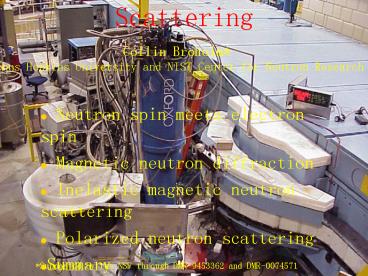Magnetic Neutron Scattering - PowerPoint PPT Presentation
1 / 17
Title:
Magnetic Neutron Scattering
Description:
Johns Hopkins University and NIST Center for Neutron Research ... They are related by the fluctuation dissipation theorem. w. k. ab. r. S ... – PowerPoint PPT presentation
Number of Views:84
Avg rating:3.0/5.0
Title: Magnetic Neutron Scattering
1
Magnetic Neutron Scattering
Collin Broholm Johns Hopkins University and NIST
Center for Neutron Research
- Neutron spin meets electron spin
- Magnetic neutron diffraction
- Inelastic magnetic neutron scattering
- Polarized neutron scattering
- Summary
Supported by the NSF through DMR-9453362 and
DMR-0074571
2
Magnetic properties of the neutron
The neutron has a dipole moment
mn is 960 times smaller than the electron moment
A dipole in a magnetic field has potential energy
Correspondingly the field exerts a torque and a
force
driving the neutron parallel to high field regions
3
The transition matrix element
The dipole moment of unfilled shells yield
inhomog. B-field
The magnetic neutron senses the field
The transition matrix element in Fermis golden
rule
Magnetic scattering is as strong as nuclear
scattering
It is sensitive to atomic dipole moment perp. to
4
The magnetic scattering cross section
Spin density spread out scattering decreases
at high k
The magnetic neutron scattering cross section
For unspecified incident final neutron spin
states
5
Un-polarized magnetic scattering
6
Magnetic neutron diffraction
Time independent spin correlations elastic
scattering
Periodic magnetic structures Magnetic
Bragg peaks
Magnetic primitive unit cell greater than
chemical P.U.C.
Magnetic Brillouin zone smaller than chemical
B.Z.
The magnetic vector structure factor is
7
Simple cubic antiferromagnet
Real space
Reciprocal Space
8
Not so simple Heli-magnet MnO2
c
b
a
characterize structure
and
Insert into diffraction cross section to obtain
9
Understanding Inelastic Magnetic Scattering
Isolate the interesting part of the cross
section
The scattering law is defined as
for a wide class of systems It satisfies useful
sum-rules
Detailed balance
Total moment
First moment sum-rule
10
Scattering from a quantum spin liquid
Dimerized spin-1/2 system copper nitrate
11
Why a gap in spectrum of dimerized spin system
- A spin-1/2 pair has a singlet - triplet gap
- Weak inter-dimer coupling cannot close gap
- Bond alternation is relevant operator for quantum
critical uniform spin chain - infinitesimal bond alternation yields gap
12
Sum rules and the single mode approximation
When a coherent mode dominates the spectrum
Sum-rules link S(q) and e(q)
q (p)
13
Spin waves in a ferromagnet
Magnon creation
Magnon destruction
Dispersion relation
Gadolinium
Magnon occupation prob.
14
Spin waves in an antiferromagnet
Dispersion relation
15
and the magnetic susceptibility
r
(
)
ab
w
k
S
,
Compare to the generalized susceptibility
They are related by the fluctuation dissipation
theorem
16
Polarized magnetic neutron scattering
Specify the incident and final neutron spin state
Non spin flip
Spin flip
17
Polarized neutron scattering
Nuclear isotope incoherent scattering
Paramagnetic scattering MnF2
H//k
H//k
SF
SF
NSF
NSF
18
Summary
- The neutron has a small dipole moment that causes
it to scatter from inhomogeneous internal fields
produced by electrons - The magnetic scattering cross section is similar
in magnitude to the nuclear cross section - Elastic magnetic scattering probes static
magnetic structure - Inelastic magnetic scattering probes spin
dynamics through - Polarized neutrons can distinguish magnetic and
nuclear scattering and specific spin components































